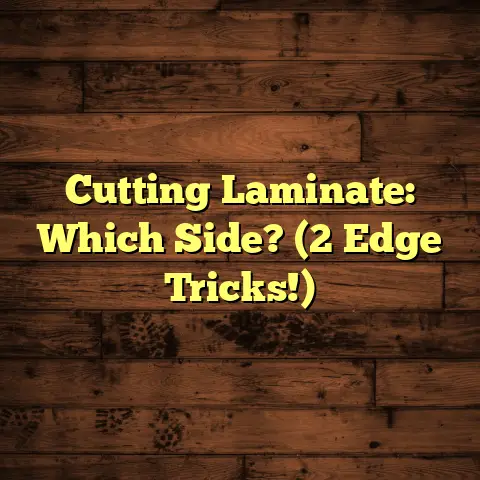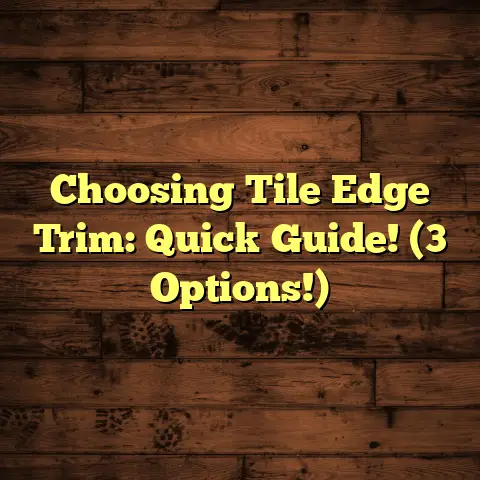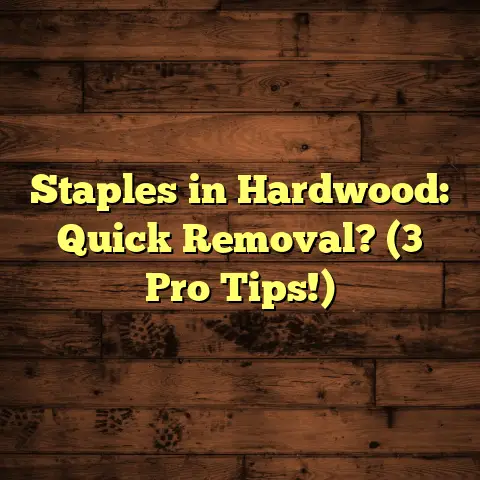Choosing The Right Wood Floor Threshold? (1 Mistake)
In this age of crazy flooring innovation, with materials getting smarter and installations getting slicker, there’s still one major pitfall homeowners keep stumbling into. What is that? Choosing the wrong wood floor threshold.
Thresholds? Yeah, those little strips that bridge the gap between different floors. Seems simple, right? But trust me, the wrong choice can ruin your whole vibe and cause headaches down the road.
In this article, I’m gonna spill the beans on that one crucial mistake, why it happens, and how you can avoid it. Let’s dive in!
Section 1: Understanding Wood Floor Thresholds
So, what are wood floor thresholds, anyway?
Basically, they’re transition pieces that cover the gap where two different flooring surfaces meet. Think of them as the unsung heroes of your home, preventing tripping hazards, hiding ugly seams, and even helping to seal out moisture.
They come in all shapes and sizes, each with a specific job. Here are a few common types:
-
T-Molding: This is your go-to for transitioning between two floors of the same height. It’s shaped like a “T” (duh!) and sits neatly between the floors.
-
Reducer Strips: Got a height difference between your floors? Reducer strips are your friend. They slope down from the higher floor to the lower one, creating a smooth transition.
-
End Caps (or Square Nose): These are used when your wood floor meets a vertical surface, like a doorway or a sliding glass door. They provide a finished edge and prevent damage to the wood.
-
Overlap Reducer: This is typically used when transitioning to carpet. It overlaps the carpet edge, providing a clean and secure finish.
Choosing the right threshold is crucial. It’s not just about looks (though that’s important too!). A well-chosen threshold can:
-
Enhance the overall aesthetic: A threshold that complements your floors can tie the whole room together.
-
Improve functionality: Proper transitions prevent trips and falls, especially for kids and older adults.
-
Protect your floors: Thresholds can help prevent moisture from seeping under your floors, which can lead to warping and other damage.
-
Increase home value: A well-executed flooring job, including the thresholds, can increase the value of your property.
Section 2: The One Common Mistake
Alright, let’s get down to brass tacks. What’s the biggest mistake I see homeowners making when it comes to wood floor thresholds?
It’s choosing a threshold that doesn’t match the flooring type or finish.
Sounds simple, right? You’d be surprised how often this happens! I’ve seen dark oak floors paired with light maple thresholds, glossy finishes next to matte ones… it’s a recipe for disaster.
So, what’s the big deal? Why is this such a major faux pas?
Well, the consequences can be pretty significant:
-
Aesthetic Disaster: The most obvious problem is that it just looks bad. A mismatched threshold sticks out like a sore thumb and can ruin the entire look of your room. It creates a visual disconnect and makes your space look unfinished and unprofessional.
-
Compromised Durability: Different flooring materials expand and contract at different rates. If your threshold doesn’t match your flooring, it can create stress points that lead to cracking, warping, or even complete failure of the threshold itself.
-
Functionality Issues: A poorly chosen threshold can create tripping hazards, especially if it’s not flush with the surrounding floors. It can also fail to properly seal against moisture, leading to water damage and mold growth.
-
Reduced Lifespan: An ill-fitting threshold can cause wear and tear on your flooring. For instance, if the transition isn’t smooth, you might scuff or damage the edges of your wood floor every time you walk across it.
Section 3: Exploring the Factors Behind the Mistake
Okay, so we know the mistake is choosing the wrong match for the threshold. But why does this happen so often?
Here are a few reasons I’ve observed over the years:
-
Lack of Research: Let’s face it, most homeowners don’t spend hours researching thresholds. They might just grab whatever looks “close enough” at the hardware store without really understanding the different types and finishes available.
-
Influence of Trends: Design trends can be a powerful force. Sometimes, homeowners get so caught up in the latest styles that they forget about the practical considerations. For example, they might choose a trendy metal threshold even though it clashes with their traditional wood floors.
-
Underestimating the Importance of the Transition: Many homeowners see thresholds as an afterthought. They focus on the main flooring materials and don’t realize that the transition is just as important. They might think, “Oh, it’s just a little strip of wood, it doesn’t really matter.” But it does matter!
-
DIY Gone Wrong: I love a good DIY project, but flooring can be tricky. If you’re not experienced, it’s easy to make mistakes, especially when it comes to thresholds. Improper installation or cutting corners can lead to mismatched or poorly fitted transitions.
Section 4: The Role of Technology in Threshold Selection
Now, let’s talk about how technology is changing the game when it comes to thresholds. It’s not just about basic wood strips anymore!
-
Innovative Materials: We’re seeing new materials that are more durable, moisture-resistant, and visually appealing. Think composite materials that mimic the look of real wood but are less prone to warping or cracking. Or metal thresholds with advanced coatings that resist scratches and corrosion.
-
Precision Manufacturing: Modern manufacturing techniques allow for more precise cuts and finishes. This means you can get thresholds that fit perfectly and seamlessly blend with your flooring.
- For example, laser cutting technology allows for intricate designs and perfect alignment.
-
Smart Integration: Okay, this is still pretty cutting-edge, but we’re starting to see “smart” thresholds that incorporate sensors for temperature control or humidity detection. These sensors can help you monitor your home’s environment and prevent moisture damage.
-
Online Tools and Resources: The internet has made it easier than ever to research different types of thresholds and find the perfect match for your flooring. Many manufacturers offer online tools that allow you to visualize different threshold options in your home.
Section 5: Case Studies of Threshold Mistakes
Let’s get real for a minute. I want to share a few real-life examples of threshold mistakes I’ve seen over the years. These are the kind of situations that make me cringe!
Case Study 1: The Mismatched Maple
-
The Situation: A homeowner installed beautiful dark walnut hardwood floors throughout their living room and dining room. They then decided to transition to a light maple tile in the kitchen. They picked up a maple threshold at a big box store, thinking it would be a simple fix.
-
The Mistake: The light maple threshold clashed horribly with the dark walnut floors. It looked cheap and out of place, and it completely ruined the flow of the space.
-
The Lesson: Always consider the overall color scheme and design of your home when choosing thresholds. Don’t just grab something that’s “close enough.”
Case Study 2: The Tripping Hazard
-
The Situation: A family installed new laminate flooring in their hallway. They used a reducer strip to transition to the existing carpet in the bedrooms.
-
The Mistake: The reducer strip wasn’t properly installed, creating a lip that stuck up above the carpet. This became a major tripping hazard, especially for their young children.
-
The Lesson: Proper installation is just as important as choosing the right threshold. If you’re not confident in your DIY skills, hire a professional.
Case Study 3: The Moisture Magnet
-
The Situation: A homeowner installed hardwood floors in their bathroom. They used a standard wood threshold to transition to the tile floor in the shower.
-
The Mistake: The wood threshold wasn’t properly sealed, allowing moisture to seep into the wood. This led to warping, mold growth, and eventually, the threshold had to be replaced.
-
The Lesson: Choose thresholds that are appropriate for the environment. In wet areas like bathrooms, opt for moisture-resistant materials like composite or metal.
Section 6: Conclusion: The Path to Successful Threshold Selection
So, there you have it! The one common mistake that can ruin your wood floor transition: choosing a threshold that doesn’t match your flooring type or finish.
It might seem like a small detail, but trust me, it can make a huge difference in the overall look and functionality of your home.
Here’s a quick recap of what we’ve covered:
-
Thresholds are important: They prevent tripping hazards, protect your floors, and enhance the overall aesthetic of your space.
-
Matching is key: Choose thresholds that complement your flooring in terms of color, material, and finish.
-
Do your research: Understand the different types of thresholds available and their specific applications.
-
Consider the environment: Choose materials that are appropriate for the room where the threshold will be installed.
-
Don’t underestimate the transition: The threshold is just as important as the main flooring materials.
-
Proper installation is crucial: If you’re not confident in your DIY skills, hire a professional.
I know, it might seem like a lot to think about. But trust me, taking the time to choose the right threshold is worth it. It’s an investment in the beauty, functionality, and longevity of your floors.
So, go forth and conquer those transitions! And if you ever need a hand, you know where to find me. Happy flooring!





